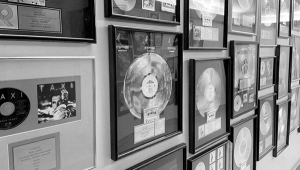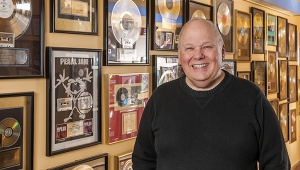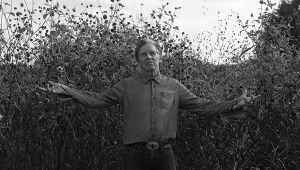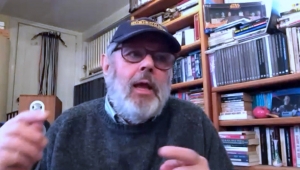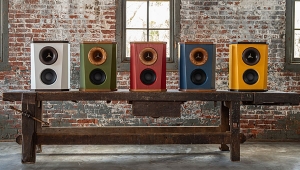| Columns Retired Columns & Blogs |
Dan D'Agostino of Krell: Power Is As Power Does
Maybe Dan D'Agostino was destined to develop and build a line of products distinguished by their sheer might. After all, he grew up just blocks from a natural phenomenon synonymous with power: Niagara Falls. Even today, when the 56-year-old D'Agostino returns to his boyhood home to visit his parents, he enjoys pulling on a pair of shorts and going for a long run in the adjacent park, which resounds with the Falls' unrelenting thunder.
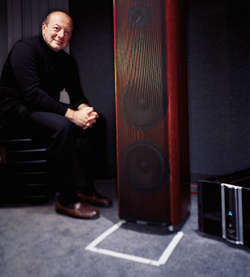 D'Agostino's father, Frank, a machinist by training, owned and operated an appliance store, where Dan worked as a boy, repairing the electric timers in washing machines. He also installed car radios and assembled numerous audio-component kits for neighbors. ("They'd buy the kit, then get disgusted with it and hand it to me, and I'd build it.") During his senior year in high school, D'Agostino blueprinted and installed in a neighborhood bar a custom sound system that included four speakers, which he built into enclosures a local cabinetmaker fabricated to Dan's specifications. These and other boyhood experiences suggested that Dan D'Agostino would ultimately pursue a hands-on career in audio.
D'Agostino's father, Frank, a machinist by training, owned and operated an appliance store, where Dan worked as a boy, repairing the electric timers in washing machines. He also installed car radios and assembled numerous audio-component kits for neighbors. ("They'd buy the kit, then get disgusted with it and hand it to me, and I'd build it.") During his senior year in high school, D'Agostino blueprinted and installed in a neighborhood bar a custom sound system that included four speakers, which he built into enclosures a local cabinetmaker fabricated to Dan's specifications. These and other boyhood experiences suggested that Dan D'Agostino would ultimately pursue a hands-on career in audio.
David Lander: Your early forays into electronics included repair work on an unusual home-entertainment product: a 78rpm record player that also cut vinyl discs. Somewhere, your father, who loved music, had bought this for the living room of your house. How did it work?
Dan D'Agostino: It had a recording arm and a playback arm, and you could record from the radio. If you heard something you really liked, you could hit a button and it would record on vinyl. The cutter stopped working—I think I was 11 or 12 years old—and no one knew how to fix it. I decided I was going to see exactly how this thing worked, so I took the back off and saw what I know now is a voltage divider, from the plate of the amplifier output tube that actually drove the cutter head. There was this giant resistor, and it had burned out, so I brought it to school and talked to my shop teacher about it. He said, "You've got to get another one." So I went to a place that sold tubes and replacement parts for televisions, which in those days was big business. I showed them this thing, and the guy said, "I can't get that. You've got to call the manufacturer." I called, and they were out of business.
Now we didn't know what the resistance value was, because we didn't have a schematic, but I started playing around with bulbs—tiny neon bulbs on a string. When I used a meter, I realized that so many [bulbs] dropped a certain amount of voltage. Then I decided to make a very bold move, and I took the arm apart, and I saw on the armature of the cutter head that it took 48 volts. I knew that the plate voltage and the tube was 200, so I tried to figure out how many of those neon bulbs I needed to get to 48 volts. It was very primitive, but I bought a string of neon bulbs and wired them all in series to the tube, and I hooked that up to the cutter head, and it started working again. The best part is, when you looked inside, all those things were glowing.
Lander: Did your obvious aptitude for electronics lead you to consider eventually earning your living in the field?
D'Agostino: I didn't even think about it.
Lander: But you kept at it throughout your teens, on the one hand to make a few dollars, on the other because of an intense interest in working with audio products. One thing you've said you modified way back when was a transistor radio. Tell us about that.
D'Agostino: Lafayette Radio came out with a little rectangular one. I bought it and took it to the beach, and the batteries went immediately. I read in Popular Science about solar cells. A local store had them in stock—they were just sitting there as a curiosity, 10 or 12 cents apiece—and I figured out how many I had to put in series to get the output I needed. I hooked them up, and I went out in the sun, and the radio played. I probably had the only solar-powered transistor radio on earth.
Lander: Well, you've come about as far as possible from transistor radios. How do you feel about the fact that the Krell name has come to stand for high power?
D'Agostino: I have to go back to what Muhammad Ali said: "Float like a butterfly. Sting like a bee." He was a powerful boxer, but he had finesse. Anyone can build a very powerful amplifier. The point is building one that sounds good, and one that sounds good at low volume levels.
Lander: Your first amp, the KSA-100, produced 100 watts at a time when the benchmark unit in the field, the Mark Levinson ML2, was rated at 25W. Why did you quadruple the power?
D'Agostino: I started looking into why I needed it. I'm always reminded of an article [Stereo Review's] Julian Hirsch wrote many, many years ago about how much power it took to reproduce a piano on a pair of AR loudspeakers. It was some extraordinary amount of power. That's what got me started, because it occurred to me that the tips of musical material, the peaks, got clipped off. We may not consciously hear it, but some part of us does, and it's the difference between what's real and what's not.
Lander: Why did you employ a class-A design?
D'Agostino: The amplifier wasn't originally intended to be class-A, but a lot of people were interested in it and talked about it in glowing terms, so I changed a part of my design. I did that, and I listened, and lo and behold, it did sound better. It absolutely sounded better, and it sounded better in the areas that audiophiles listen to: the center image, the fact that the image didn't drift. There was more air around the music, and it seemed to have a wider, much deeper soundstage. All those things were more apparent when that amplifier was operating in class-A mode.
After doing a lot of research, I decided it was feasible to build a 100-watt, pure class-A amplifier. I didn't think anything smaller was big enough power-wise, and anything bigger became more of an engineering monster. It did use fans—they were quiet—and I spent a lot of time figuring out how to make it usable for the average guy, because the heatsinks operated at about 75-80$dC, which is just a bit cooler than a clothes iron when it's heated up. So I put really tall feet on the amplifier, and the heatsinks were exposed on the bottom. A little fan was sucking air in and blowing it out, and that enabled me to run it in class-A mode in a relatively small box.
Lander: How do you respond to people who listen through your amplifiers and claim to hear a distinctive Krell sound?
D'Agostino: We strive to get the maximum amount of bandwidth and use the minimum amount of filtering. I guess that's created a sound, but we haven't done any modeling to satisfy our own particular preferences. I've never wanted to make an amplifier like that, because I've always thought it would color a good recording.
Lander: Tell us about Sustained Plateau Biasing, which was a 1990s Krell innovation.
D'Agostino: It came from a desire to make larger class-A amplifiers. With [conventional] sliding bias, you're turning the transistor on really hard, then turning it off in conjunction with the incoming musical signal, which creates very unusual and nonlinear distortions in the output stage. What's wrong with it is that it's changing with the music. What's right is that, at idle, it's not drawing a lot of current. I thought about a lot of things, and one was the sustain pedal on a piano. When you push it down, the note hangs on. I asked myself why I couldn't ramp up the bias to the level of class-A that I needed and just hold it there for a period of time. And if another signal comes in that's higher, go up another level and hold it there. And if the level goes back down, after a period of time, which is usually 60 to 90 seconds, go back down as needed. So you get the amount of class-A you need, never more or less. And you're not changing the output stage with the musical signal. Sustained Plateau Bias allowed me to get huge amounts of class-A power for short periods of time.
- Log in or register to post comments

